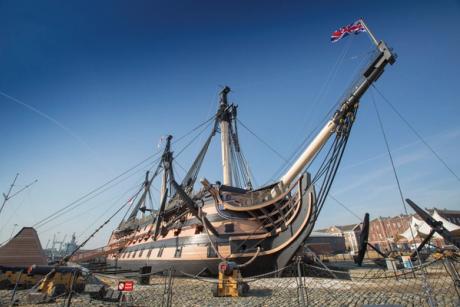
Every day hundreds more photographs are added to the database recording progress on Nelson’s flagship HMS Victory in Portsmouth’s Historic Dockyard, its ribs gaping as shipwrights strip out wood decayed beyond salvation or patch in new timber to fill holes. The images record every inch of work that the team hopes will keep the ship sound for the next half century. Crucially for the first time Artificial Intelligence (AI) has been used to help speed up the process, in a pioneering project developed with Masters students from the University of Southampton.
Traditionally records were added to museum collections on individual cards in spidery handwriting. Digitisation has speeded up the process, but each entry still has to be made individually by a human being. The AI programme developed for HMS Victory is still a work in progress, but already some images are automatically being tagged and added to the database and the digital 3D model of one of the most famous ships ever built.
The programme is also learning to recognise and match images stored in different sections of the database. Bart Baesens, a lecturer at Southampton and professor of big data and analytics at KU Leuven University in Belgium, who supervised students Siddhi Mahendra Pawar, Donheng Wang and Arundati Roy, said they had used large language models—deep learning algorithms which can recognise, summarise and generate content—to automatically classify images and artefacts. “We think this could be of great interest to the wider cultural world, for institutions looking to quickly, efficiently and accurately enrich the data relating to their collections,” Baesens says.
HMS Victory, on which Admiral Lord Nelson sailed to defeat the French and Spanish forces and his own death at the Battle of Trafalgar in 1805, is now the oldest ship in the world still in naval commission. Although it has been a tourist attraction in the dockyard since 1922, and is now in the care of the National Museum of the Royal Navy, technically it remains part of the navy as the flagship of the First Sea Lord.
Rotten wood, ruinous costs
The naval historian Brian Lavery recorded that, in 1884, a visiting admiral remarked that he could run his walking stick through the holes in HMS Victory’s sides, commenting: “A more rotten ship than she had become probably never flew the pennant.” Ruinously expensive repairs have been continuous since 1765. It was refitted for Trafalgar, and only sentimental devotion to the dead naval hero saved her from being scuttled after the battle. Ever since, there have been many public appeals to save this icon of the Royal Navy and maritime history.
HMS Victory remained afloat for more than a century after Trafalgar, used variously as a store and for training, and only moved to permanent dry dock in 1922 where it was virtually rebuilt. Further extensive repairs were needed after the Second World War when bomb-shattered masonry blew a gaping hole in the hull, and yet another “save the Victory” fund was launched in the 1950s.
The last major restoration was in the 1990s, but the current programme, The Big Repair, projected to last at least ten years and funded mainly by the National Museum of the Royal Navy, is the most extensive in a century, estimated at £42m. The ship, its prow and stern protruding from a giant tent of scaffolding and tarpaulin, rigging and masts dismantled, remains open to visitors who can watch the work.
In each major repair, people worried that less and less survived of the 1805 ship, though master shipwright Leonardo Bortolami believes that at least 20% of the original fabric remains. This time massive ribs and acres of planking will have to be replaced completely, including much that had been replaced in the 1990s.
The original ship was oak, but the problem over the last century has been sourcing the wood. “[Oak] is simply not to be had,” Bortolami says, adding: “You would need 6,000 perfectly straight oak trees, and they do not exist in England, or I believe anywhere.” Some teak is being used again this time—from timber bought by the navy decades ago—but the visible timbers will be oak, laminated to get the massive sections needed for the ribs. The source of the oak might cause Nelson to turn in his St Paul’s Cathedral grave (it is French).
Another major issue is what Rodrigo Pacheco-Ruiz, an archaeologist and data manager at the museum, and visiting fellow in maritime archaeology at Southampton, calls the “oldest original indigenous population of Victory”, namely the voracious deathwatch beetles, possibly descendants of those in the ship since the launch.
In the 1950s after repeated fumigation, it was announced that only 45 beetles remained. But their descendants have survived and flourished and are now spreading to neighbouring structures but they are of great interest to scientists as a distinct HMS Victory variety. How to deal with them this time is still being researched.










